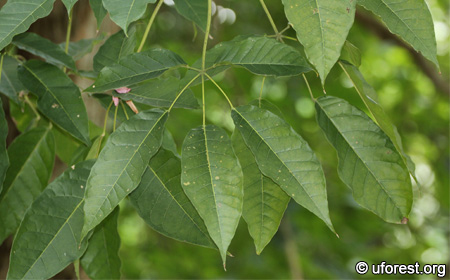| Etymology | Genus | From its Brazilian common name 'tabebuia'. |
|---|---|---|
| Species | Rosy or rose-coloured | |
| Family | Bignoniaceae | |
| Synonyms | Tecoma rosea Bertol. | |
| Common Names | Trumpet Tree, New World Trumpet | |
| Status | Exotic: Casual | |
| Form | Tree | |
| Native Distribution | Tropical America | |
Diagnostics:
Among all the Tabebuia species planted in Singapore, this is the only one where the leaflets are the largest, and ends with sharp apiculate tips. There are species that have similar looking leaves, like Ceiba pentandra and Sterculia foetida but their leaflets are stalkless.
Interesting Facts:
Tabebuia rosea is a very popular tree planted along roads and parks. As of 2009 (Tan et al., 2009), its total numbers in parks and streetscapes managed by NParks put it as the top 6th most commonly cultivated tree with 13,299 individuals.As with its other congeners, the leaves are palmately compound with five stalked leaflets. During the months of Apr, and Aug-Sep, a spectacular bloom occurs, and the entire tree will be covered by its pink or white flowers. The flowers drop after awhile and the grass patch beneath will be then covered by a carpet of pink or white. The fruits are long pods which split open to release winged seeds that rotate like a helicopter to slow their descend, aiding dispersal.

Tabebuia rosea in full bloom.

The riped fruit splits longitudinally, revealing rows of winged seeds.

Palmately compound leaves, with each leaflet having an acute tip.

Fissured bark, a characteristic of Tabebuia species.

Flowers are rosy pink with yellowish centre.

Translucent winged seeds.
References
Tan PY, B Yeo, WX Yip & HS Lua. (2009) Carbon Storage and Sequestration by Urban Trees in Singapore. Centre for Urban Greenery and Ecology, National Parks Board, Singapore. 14 pp.Author: Siyang
Posted: 2012-10-06 / Modified: 2019-08-27